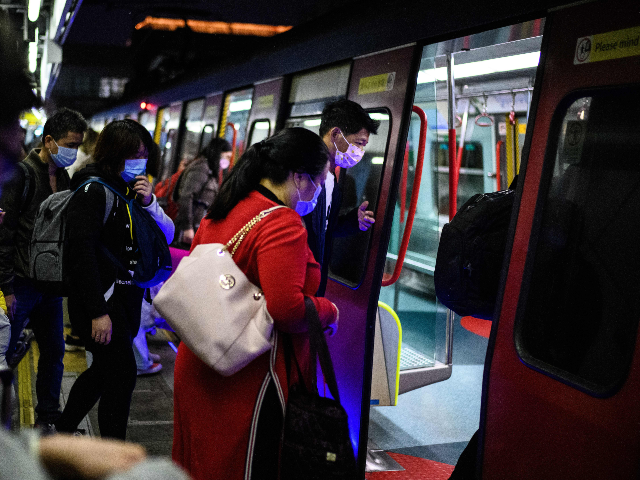Health authorities in Hong Kong announced Monday that they have procured 500 electric trackers to place on individuals suspected of being infected with the new form of coronavirus originating in China last month.
The Hong Kong government is ordering anyone residing in Hong Kong present in the city or returning to it after visiting Hubei province – whose capital, Wuhan, is the location where the virus is believed to have first jumped from animals to humans – in the last two weeks into quarantine at home. To ensure that no one violates the 14-day isolation period and puts others in the population at risk, officials will use wristbands to monitor their location.
The trackers will be tied to the wearer’s smartphone via Bluetooth technology. The phone’s GPS technology will provide the person’s location – if the phone leaves the permitted area, or if the wristband reaches more than a 20-meter distance away from the phone, the government will consider the wearer in breach of the quarantine. Destroying the wristband or taking it off will also count as breaches.
Hong Kong’s Chief Information Officer Victor Lam debuted the wristbands in a press conference Monday, where he warned that violations found with the wristband could result in up to a six-month prison term or fined the equivalent of U.S. $644. He emphasized that the tags themselves do not have GPS technology, so the government will not monitor the wearer’s every move, providing a minimum of privacy. He also noted that the government will soon count on another 1,000 wristbands to use similarly.
The move is part of a growing response to the coronavirus outbreak currently ravaging China and threatening the rest of the world. The Chinese government revealed on January 20 – nearly a month after secretly alerting the World Health Organization (WHO) – that it had identified a never-before-seen coronavirus spreading in Wuhan, a city of 11 million. China shut down the wild meat market where the virus is believed to have originated on January 1, and local officials instituted a lockdown in Wuhan, preventing entry or exit and stopping mass transit, a week after the announcement of the new virus.
Hong Kong has identified 15 cases of novel coronavirus as of Monday, according to the Asian outlet Coconuts. The city has identified potentially hundreds of cases, increasingly running out of spaces to isolate them and prevent the outbreak from growing, hence the introduction of at-home measures.
Isolation is especially important in light of authorities warning on Sunday that they may have identified a case of coronavirus passed from human to human within Hong Kong – rather than the case of a person returning from Wuhan already carrying it.
“Hong Kong can become another Wuhan,” Yuen Kwok-yung, a University of Hong Kong microbiologist, said on Sunday, according to local broadcaster RTHK. Yuen suggested increased border controls to keep carriers out of the city, noting that Guangdong, the Chinese province that borders Hong Kong, is one of the most affected by the outbreak.
The individual identified as a potential human-to-human case is a patient that has reportedly not traveled outside Hong Kong within a time frame that would have made it possible to get the virus from someone abroad.
Hong Kong Chief Executive Carrie Lam has limited the flow of travelers from China, but refused to shut down the border completely, triggering widespread protests and a general strike of Hong Kong healthcare workers at a pivotal time in fighting the outbreak. Lam has taken to shutting border crossings piecemeal, and on Monday announced that all but three crossings will remain open. One of them is Hong Kong’s international airport, where government officials insist they have installed enough security measures to catch incoming cases.
Lam cited a “genuine and legitimate” need by many in Hong Kong to travel into and out of China on a regular basis for leaving the border crossings open.
Many in Hong Kong, already protesting Lam’s close ties to the Communist Party of China for half a year before the outbreak began, have not accepted her explanation. On Monday, RTHK reported that dozens of Hong Kong residents took to the streets during their lunch breaks from work to demand a complete closure of Hong Kong’s borders to China. The crowd, some chanting “close the border, say no to China,” sang Hong Kong democracy protest albums and demanded an end to the closures until police threatened them with potential action in light of them being “suspected of taking part in an unlawful assembly,” RTHK noted.
Also on Monday, thousands of healthcare workers began their strike against the government. As they are the first to interact with potential coronavirus cases, an open border is riskiest for them.
“If there is no full border closure, there won’t be enough manpower, protective equipment, or isolation rooms, to combat the outbreak”, Winnie Yu, the chairman of the Hospital Authority Employees Alliance, told reporters. The first day of striking would only include non-essential healthcare workers, though that may change in the near future.
“We reiterate… we hospital staff are being forced into taking this desperate move of taking industrial action by those in power,” Yu said. “We welcome the government at any time, to join in open talks with the Hospital Authority to give concrete responses to our demands, to resolve this current impasse.”

COMMENTS
Please let us know if you're having issues with commenting.